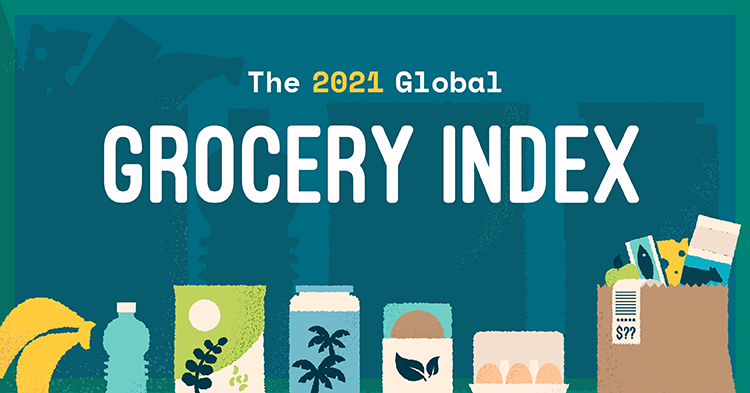The global pandemic put the humble grocery basket in the spotlight. More to the point, it was the basket’s contents – or lack of contents – that concerned the world.
Panic-buying for toilet paper became a meme in 2020. The baking craze made flour a rare commodity. But at the same time, 2.37 billion people – one in three humans – suffered from food insecurity, unable to afford a balanced and nutritious diet. That’s a rise of 320 million people due to the pandemic. In the US, grocery prices are likely to keep rising.
Meanwhile, in the UK, coronavirus and Brexit have led to a shortage of truck drivers and a shortage of food on the shelves. This is a land where the national security agency believes society is only ever “four meals away from anarchy” – and where prime minister Boris Johnson once said, “I don’t know how much a pint of milk costs – so what?”
But the price of essential groceries does matter – and so does how that cost relates to your income. NetCredit designed a shopping list of staple foods and researched how much it would cost to buy in grocery stores around the world, plus affordability compared to local wages. And then we did the same for a vegan shopping list, too.
Key Findings
- Switzerland has the most expensive essentials in the world – costing $52.95 for a regular basket of groceries.
- The cost for the same groceries in Djibouti is $6.89, just 13% of the price in Switzerland.
- The United States has the most affordable regular and vegan essentials in the world – in each case, our sample basket of food costs around 12% of the average day’s pay.
- The United Arab Emirates has the world’s most expensive vegan food, costing more than double its non-vegan equivalent.
Djibouti, Moldova and Paraguay Have the World’s Cheapest Groceries – but the US is Most Affordable
First, we assembled a shopping list of essential foods. Then we checked this list against the prices listed on supermarket websites around the world. Here’s what the totals include:
Breakfast Cereal | Eggs (regular) (12) | Boneless chicken breast (500g / 1lb) | 500g (16 oz.) of local cheese | Vegetable oil (1 liter bottle) | Loaf of fresh white bread (500g) | Milk (regular) (1 liter) | Potato (1kg / 2lb) | Tomato (1kg / 2lb) | Banana (1kg / 2lb) | Canned tuna (140g) | Water (1.5 liter bottle)
We then calculated the affordability of this basket in each country as a percentage of the average daily wage.
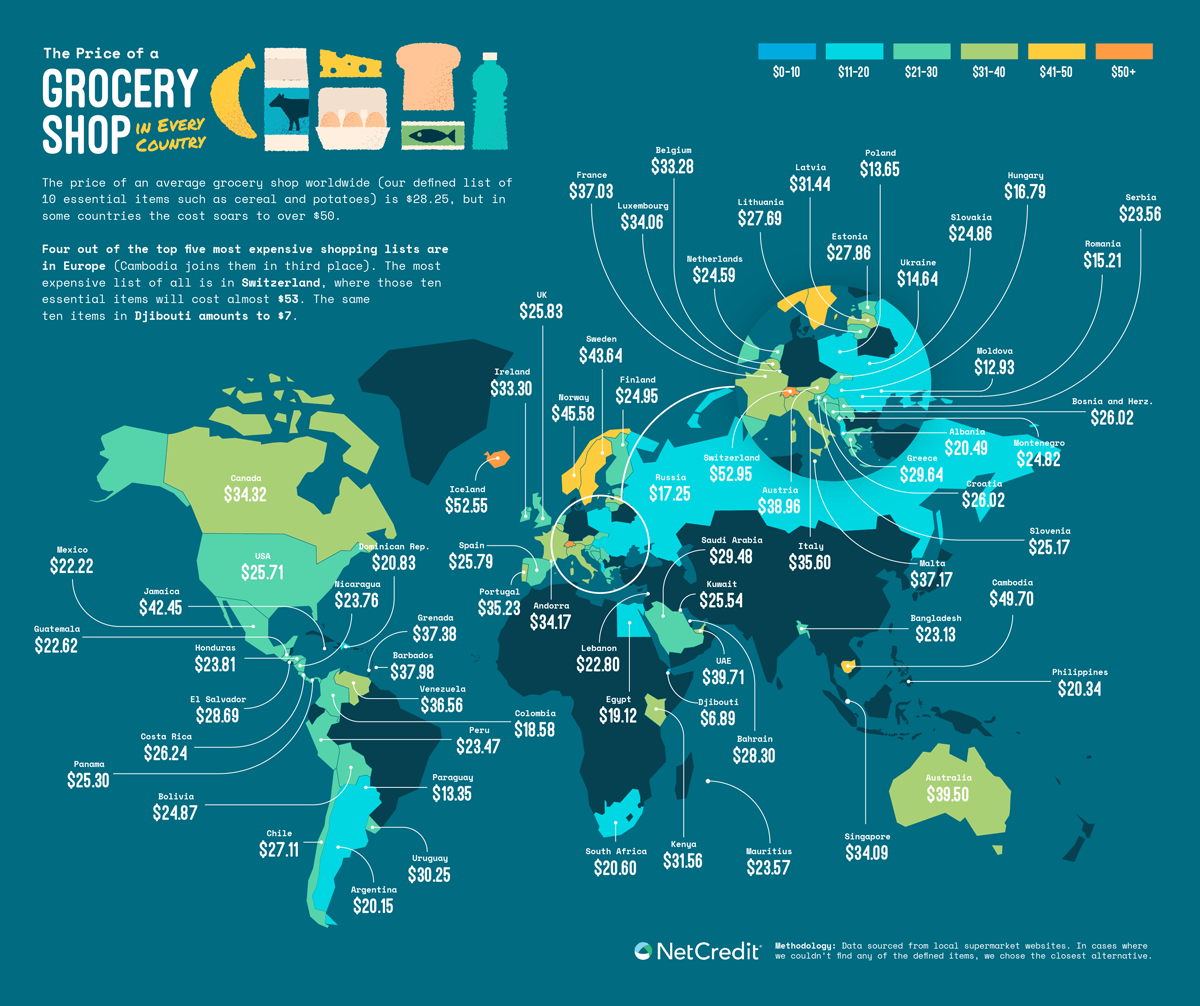
Europe dominates the map for expensive shopping baskets. The top two countries, and 11 of the top 20, are in Europe. The most expensive European groceries are in the countries with among the highest incomes. Indeed, Norway and Switzerland are in the top 10 most expensive, yet are also in the top 10 most affordable – because wages are still very high compared to costs.
However, the top 10 most expensive also includes two countries with relatively low wages: Jamaica and Cambodia. This basket costs $49.70 in Cambodia, number three in the world. The average daily income is just $5.28. That means the average worker would need to toil for nearly 9½ days to afford basic groceries. This disparity is partly due to differences in earnings and lifestyles between urban areas and underdeveloped country regions.
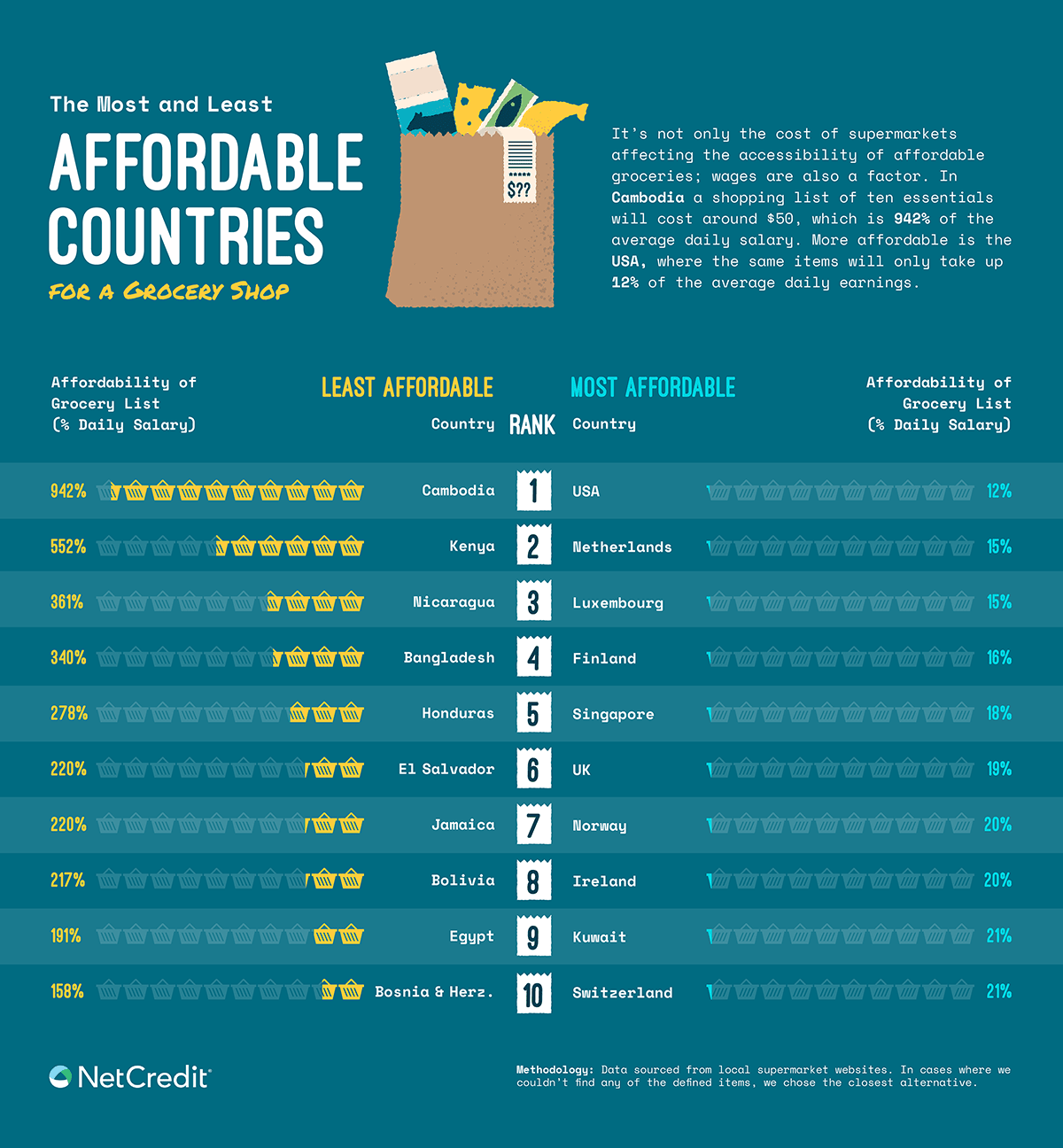
Europe is also the source of some of the world’s cheapest groceries. Six of the 10 cheapest baskets are in central or eastern Europe. However, the overall cheapest is in Djibouti, and number 10 is Egypt – suggesting more African nations would dominate the cheapest groceries if the data were available.
Despite these low prices, none of the cheapest grocery markets are among the most affordable. The best overall deal is in Poland, with the world’s fourth-cheapest groceries and 20th-best affordability (26.88% of the average daily wage). This suggests that wages, rather than prices, have a more significant impact on grocery affordability.
The United States has the most affordable groceries in the world, with giant stores and bulk buying, allowing for an affordability rate of 12.11%. However, since the US has some of the worst economic inequality in the world, shopping for groceries is still an anxiety-inducing activity for many Americans.
Poland Has the Cheapest Vegan Essentials, but the US Has the Most Affordable
Next, we did it all over again, but with a vegan-ized shopping list:
Vegan breakfast cereal | Canned chickpeas | Frozen veggie burgers (example: soy patties) | Vegan cheese | Coconut oil (500ml) | Loaf of fresh white bread (500g) | Soy milk (1 liter) | Potato (1kg / 2lb) | Tomato (1kg / 2lb) | Banana (1kg / 2lb) | Brown rice (1kg) | Water (1.5 liter bottle)
The US jumps from the world’s 33rd cheapest grocery haul to number 10 if you switch to a vegan diet – in fact, the American vegan basket costs just 33¢ more than the regular one.
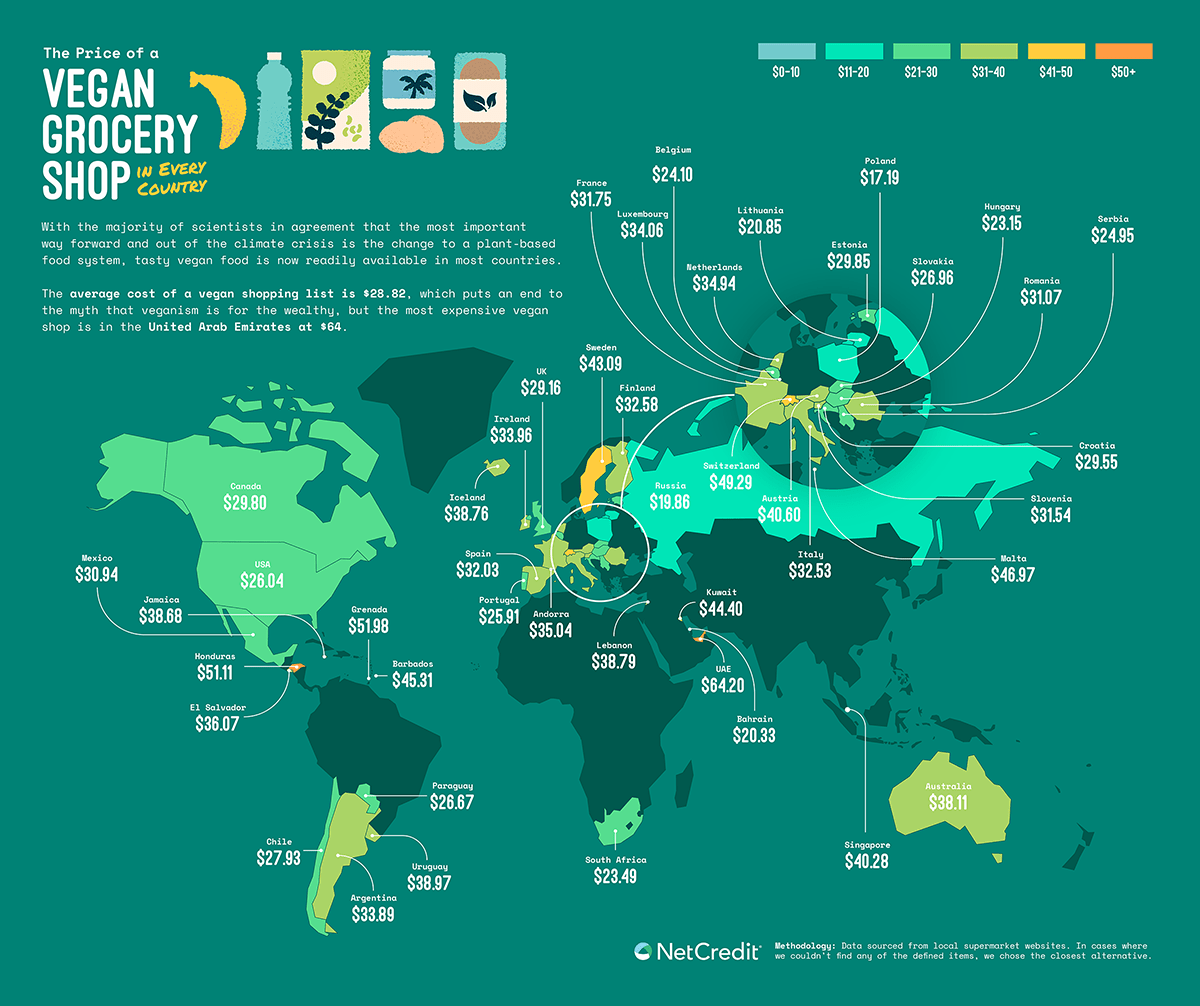
Poland leaps into top position as the cheapest place for basic groceries if you’re vegan. This is partly due to a lack of vegan products in Djibouti and Moldova, which are cheaper than Poland for non-vegan groceries. Paraguay is also cheaper than Poland until you switch to vegan: the price of a basket of food in Paraguay doubles when you ditch animal products. In Poland, it rises by just under $4, or 26%.
The US remains in top position for most affordable groceries if you switch to vegan. In America, it takes 12.26% of the average daily pay to afford this basket of vegan food. The States is closely followed by high-income countries such as Iceland and Switzerland, and countries with moderate incomes and reasonable food prices, including Belgium, Canada and the UK.
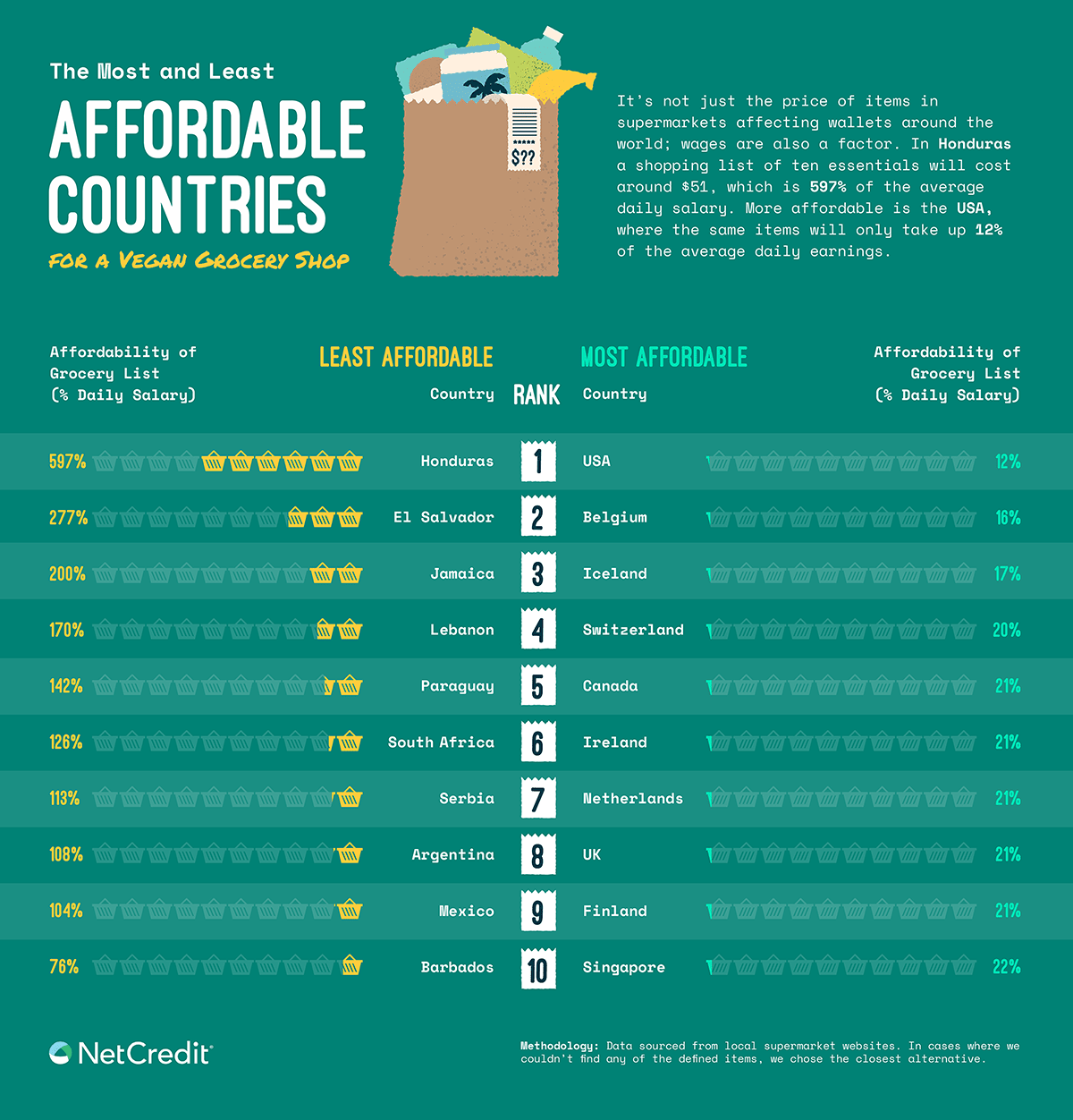
The United Arab Emirates has the most expensive vegan essentials, costing 61.7% more than their regular versions. Switzerland remains a pricey market, even though a basket of vegan food costs nearly $4 less than standard. Iceland, Jamaica and Australia are among other countries where the vegan shopping list costs less than the regular version.
The least affordable vegan basket is in Honduras, where it costs 596.59% of the daily paycheck (i.e., around six day’s wages). The Honduras vegan list costs more than double the non-vegan list.
Only around two-thirds of the countries with data for a regular basket also had comparable vegan alternatives. But things are changing. By 2020, all of the UK’s top supermarkets had their own vegan range. Asda – owned by Walmart – even trialed a ‘vegan butchers’ counter. In the US, sales of “plant-based foods that directly replace animal products” grew 27% during the first year of the pandemic.
The Catastrophic Cost of Groceries
Bill Gates was shocked to find that dip costs under ten bucks.
In the hit show Succession, rags-to-riches billionaire Logan Roy tests his adult son on the price of milk. “I don’t know,” comes Kieran Culkin’s dismissive reply: “Literally no-one knows.”
The affordability of groceries is a political issue. Climate change and the population boom mean the very availability of essential foods will continue to trouble all but the super-wealthy long after the Covid-19 supply chain problem is gone. Switching to vegan products may make a difference – although much of the damage is structural.
“Most of what you can do at an individual level is weak by comparison to what governments need to do,” says George Monbiot. “But changing diet does not. That has a major impact.”
You can check our full data on grocery prices around the world in the table below.
METHODOLOGY
We began by finding a supermarket with an online shop for each country. If it wasn’t possible to find an online shop we removed the country from the list. We built a list of 10 essential items for both a non-vegan and vegan shop:
Non-vegan grocery shop
- Breakfast cereal
- Eggs (regular) (12)
- Boneless chicken breast (500g / 1lb)
- 500g (16 oz.) of local cheese
- Vegetable oil (1 liter bottle)
- Loaf of fresh white bread (500g)
- Milk (regular), (1 liter)
- Potato (1kg / 2lb)
- Tomato (1kg / 2lb)
- Banana (1kg / 2lb)
- Canned tuna (140g)
- Water (1.5 liter bottle)
Vegan grocery shop
- Vegan breakfast cereal
- Canned chickpeas
- Frozen vegetable burgers (example: soy patties)
- Vegan cheese
- Coconut oil (500ml)
- Loaf of fresh white bread (500g)
- Soy milk (1 liter)
- Potato (1kg / 2lb)
- Tomato (1kg / 2lb)
- Banana (1kg / 2lb)
- Brown rice (1kg)
- Water (1.5 liter bottle)
Then we manually searched online to find the prices of the items. If we couldn’t find any items we chose the closest alternative. We found the total cost for both lists and converted the price into USD.
Using the Worldbank we gathered average daily income data for each country and used this to find the affordability percentage.


